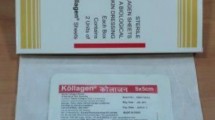Abstract
Two hundred twenty cases of unilateral chronic suppurative otitis media (CSOM) with dry central perforation were chosen for this study and myringoplasty were done. Age group ranged from 13 to 48 years. Four types of autogenous tissues were used as graft material. Grafting was done by underlay technique when temporalis fascia, tragal perichondrium, areolar tissue were used as graft material and when fat graft was used the ear lobule fat was placed directly into perforation through transcanal route. Postoperative follow-up was carried out up to 6 months. In this study, it was found that the younger age group has less impairment of hearing and better chance of tympanic membrane perforation closure than the older age group in CSOM with central perforation. Anterior perforations has less impairment of hearing and better result in successful closure of tympanic membrane than posterior perforation group. It was also observed that larger the size of perforation greater is the hearing impairment preoperatively and postoperative hearing gain is also less compared to small perforation. Best hearing improvement occurred using temporalis fascia. Failure occurred may be due to postoperative infection, respiratory tract infection, neglected post-operative advice etc.
Similar content being viewed by others
References
Palva T (1982) Pitfalls in myringoplasty. Acta Otolaryngologica 93:441
Mendel L and Kuylen SR (1985) A clinical comparison of the result of two different methods of closing tympanic membrane perforation. J Laryngol Otology 99:339–342
Storahan RW, Ward PH, Acquarelli M and Jafek B (1971) Tympanic membrane grafting analysis of materials and techniques. Ann Otorhinolaryngol 80:854–860
Hardijk, A Jand and Rietema SJ (1982) Tympanic membrane grafting with fascia, perichondrium and vein. J Laryngol Otology 96:43–47
Virtanen H, Palva T and Jauhiainen T (1980) The prognostic value of eustachian tube function measurement in tympanoplasty surgery. Acta Otolaryngologica 90:317–323
Yung MW (1983) ’Myringoplasty’ hearing gain in relation to perforation site. J Laryngol Otology 97:11–17
Lebo CP (1963) Graft selection for tympanoplasty. Ann Otorhinolaryngol 72:40–49
Eisenties JF and Hermann BW (2004) Areolar tissue graft in pediatric tympanopalsty — a pilot study. Am J Otolaryngol 25:79–85
Gierek T, Slaska-Kaspera A, Majzel K, Klimzak-Golab L (2004). Result of myringoplasty and type I tympanoplasty with the use of fascia, cartilage and perichondrium grafts. Otolaryngology Pol 58:529–533
Author information
Authors and Affiliations
Corresponding author
Rights and permissions
About this article
Cite this article
Singh, B.J., Sengupta, A., Das, S.K. et al. A comparative study of different graft materials used in myringoplasty. Indian J Otolaryngol Head Neck Surg 61, 131–134 (2009). https://doi.org/10.1007/s12070-009-0051-3
Published:
Issue Date:
DOI: https://doi.org/10.1007/s12070-009-0051-3




